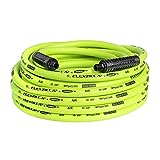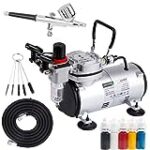🌅 Introduction
Welcome to our comprehensive air hoses buying guide! Whether you’re a professional tradesperson or a DIY enthusiast, finding the right air hose is crucial for optimal performance and efficiency. With a wide range of options available, it can be overwhelming to make the right choice. Fear not, as we’re here to simplify the process for you. In this guide, we’ll explore the key factors to consider when purchasing an air hose, including durability, flexibility, and compatibility. So, let’s dive in and find the perfect air hose that will supercharge your pneumatic tools and take your projects to new heights!
🏆 Our Top 5
- EXCELLENT MATERIAL: This air hose is blended rubber and PVC air hose is heavy duty, lightweight, flexibility,abrasion resistance and all weather use.
- EASE TO USE: Equiped with 1/4” industrial NPT fittings and quick coupler for directly connect to air compressor and air tools. No need to buy seperately air fittings.
- BOTH ENDS INSTALLED BEND RESTRICTORS: Bend restrictors reduce kinking and help to increase the life of the air hose
- HIGH STRENGTH: 3/8 INCH inner diameter by 50 FEET long delivers up to 300 PSI for maximum working pressure, 1200 PSI bursting pressure.
- TWO YEAR limited warranty
- EXTREMELY FLEXIBLE - All weather flexibility (-40° to 140°F)
- EXTREMELY DURABLE - Abrasion resistant outer cover and crush resistant aircraft aluminum fittings with bend restrictor
- HYBRID POLYMER - Won't kink under pressure, coils easily and lays flat with zero memory
- MAXIMUM WORKING PRESSURE - 300 pounds per square inch
- VERSATILITY - Use on professional jobsites, in automotive shops or at home in the garage
- 【High Quality】Our air hoses are made of high-quality polyurethane and high-strength polyester fibers, lightweight, flexible, abrasion, oil, grease resistant, anti-kink, and good adaptability to bad weather conditions.
- 【Kinking Resistant】Both ends installed bend restrictors, reduce kinking. Air compressor hose equiped with 1/4" MNPT industrial fitting and universal quick connect coupler. No need to buy separately air fittings.
- 【All Weather Use】Temperature range: -10°F to 150°F. Very flexible in extreme cold weather. Heavy duty, lightweight, durable, wear-resistant and other advantages. Max working pressure is 300PSI, 1200PSI max bursting preesure.
- 【Easy to Use】Lead-in Hose is used to connect your air hose reel to your compressor and is made to help absorb the shock loads produced by air pneumatic tools, and reduced user fatigue, and guarantees a stable air flow connection to the compressor.
- 【Quality Service】If you have any questions, please feel free to contact us. 24h customer service, two-year limited warranty.
- Professional Master Elite 50-foot hybrid polymer air hose with 1/4" NPT male end fittings, a lightweight, universal aluminum quick-coupler, and an I/M style plug. A heavy-duty 3/8" ID air hose constructed with a premium nitrile rubber/pvc hybrid polymer material that makes it super strong, very flexible, and lightweight. It weighs 30% less than most rubber hoses. The hose has a maximum working pressure of 300 PSI and a bursting pressure of 1,200 psi for a 4:1 safety factor.
- This high-performance super flexible hose is designed to be twist, kink, mar, and bend resistant. The hose has an abrasion-resistant hybrid polymer outer cover, along with an internal reinforcement layer of high-strength braided polyester, which prevents the elongation of the hose when it is under pressure. The hose ends contain bend restrictors that prevent airflow blockage, so you'll have consistent unrestricted airflow delivery.
- A versatile premium air hose that is ideal for multiple applications, including auto repair shops, body shops, construction job sites, and homes and garages. Attach the hose to an air compressor, then attach the other hose end to pneumatic air tools like sanders, grinders, nail guns, spray guns, or inflation accessories.
- The included lightweight 1/4" aluminum universal quick-coupler has a simple push-to-connect plug connection design, and the coupler accepts all 3 standard styles of interchange plug types, Industrial (I/M), Automotive (T), and ARO (A).
- A durable all-weather air hose that maintains flexibility even in extremely hot or cold temperatures (-40°F to 150°F). It is also oil, chemical, and electrically resistant. Buy with confidence; if you're not satisfied with this item at any time within the first year of purchase, we'll provide a refund or replacement.
- 25 FEET SELF-COILING: 1/4" ID and 25 ft. Long recoil hose snaps back into shape, preventing kinks and tangles to aiding in wear resistance of hose, no more wasting time coiling your hose for storage. It delivers up to 120 PSI for maximum working pressure.
- PU HOSE: Hromee recoil hose is constructed with the super-flexible polyurethane (PU) whose soft finish is less likely to scratch surfaces. It also features anti-kink, abrasion, oil, grease resistant, more durable and lightweight than nylon.
- COUPLER&PLUG KIT: This hose is equipped with one 1/4'' NPT universal coupler which fits Industrial (I/M), ARO (A) and Automotive (T) and two pieces I/M type plugs. Heavy duty steel air fittings are ideal for general purpose applications and the anodized color coating has good durability and high scratch resistance.
- SPECIAL DESIGN: The hose is equipped with double swivel 1/4” MNPT brass ends. Bend restrictors reduce kinking and increase the life of the hose. Due to very good cold weather flexibility, polyurethane hose is perfect for year round use in temperatures as low as -20℃.
- EAST TO USE: With high visibility color red, you can quickly find your hose easily on a busy job site - then attach tools to the air supply. Perfect for all air-powered equipment on the job site and in garages, plants and service stations
🤔 How to choose?
1. Length: Finding the Right Size for Your Needs
When choosing an air hose, the length is an important factor to consider. The length of the hose will determine how far you can reach with your air tools and equipment. It is crucial to choose a hose that is long enough to reach your desired work area without any restrictions.
For example, if you are working in a large garage or workshop, you may need a longer hose, such as a 50-foot or 100-foot hose, to ensure you can move around freely. On the other hand, if you are working in a smaller space, a shorter hose, like a 25-foot hose, may be more suitable.
Remember, it is always better to have a hose that is slightly longer than you need, as you can always coil up the excess length.
2. Diameter: Consider the Airflow Requirements
The diameter of the air hose is another crucial aspect to consider. The diameter determines the amount of airflow that can pass through the hose. A larger diameter hose allows for greater airflow, which is essential for tools that require high air consumption.
For instance, if you are using a heavy-duty impact wrench or a paint sprayer, you will need a hose with a larger diameter, such as 3/8 inch or 1/2 inch, to ensure sufficient airflow. On the other hand, if you are using smaller air tools, like a brad nailer or a tire inflator, a hose with a smaller diameter, such as 1/4 inch, may be sufficient.
Keep in mind that using a hose with a smaller diameter than required can result in reduced performance and efficiency of your air tools.
3. Material: Durability for Long-lasting Performance
The material of the air hose plays a significant role in its durability and longevity. Air hoses are commonly made from rubber, PVC, or hybrid materials. Each material has its own advantages and disadvantages.
Rubber hoses are known for their excellent flexibility and resistance to abrasion, making them suitable for heavy-duty applications. PVC hoses, on the other hand, are lightweight and more affordable, but they may not be as durable as rubber hoses. Hybrid hoses combine the best of both worlds, offering flexibility and durability.
Consider the type of work you will be doing and choose a hose material that can withstand the demands of your specific applications.
4. Pressure Rating: Matching the Hose to Your Tools
The pressure rating of an air hose refers to the maximum amount of pressure it can handle. It is crucial to choose a hose with a pressure rating that matches or exceeds the requirements of your air tools and equipment.
Using a hose with a lower pressure rating than required can result in leaks, reduced performance, and even damage to your tools. On the other hand, using a hose with a higher pressure rating than necessary may be unnecessary and can add unnecessary weight and cost.
Always check the pressure requirements of your air tools and choose a hose with a suitable pressure rating to ensure optimal performance and safety.
5. Fittings: Compatibility with Your Air System
The fittings on the air hose are essential for connecting the hose to your air compressor and air tools. It is crucial to ensure that the fittings on the hose are compatible with your existing air system.
Most air hoses come with standard fittings, such as NPT (National Pipe Thread) or quick-connect fittings. However, it is always a good idea to double-check and ensure that the fittings on the hose match the fittings on your air compressor and tools.
In some cases, you may need to use adapters or couplers to make the connections. Make sure to choose high-quality fittings that provide a secure and leak-free connection for optimal performance.
By considering these factors – length, diameter, material, pressure rating, and fittings – you can confidently choose the right air hose for your needs. Remember to prioritize durability, performance, and compatibility to ensure a seamless and efficient air system.
💡 What to Look for in a air hoses?
1. Durability and Material
When looking for an air hose, durability should be your top priority. A durable air hose will be able to withstand the wear and tear of regular use, ensuring that it lasts for a long time. One of the key factors that determine the durability of an air hose is the material it is made of.
**Rubber hoses** are known for their excellent durability and flexibility. They can withstand high pressure and extreme temperatures, making them suitable for a wide range of applications. Rubber hoses are also resistant to abrasion, which means they are less likely to get damaged when dragged across rough surfaces. However, they can be heavier and more expensive than other types of hoses.
**PVC hoses** are lightweight and affordable, making them a popular choice for homeowners and DIY enthusiasts. They are also resistant to kinks and tangles, which makes them easy to handle and store. However, PVC hoses may not be as durable as rubber hoses and may not be suitable for heavy-duty applications.
2. Hose Length and Diameter
The length and diameter of an air hose are important factors to consider when making a purchase. The length of the hose will determine how far you can reach with your air tools, while the diameter will affect the airflow and pressure.
**For shorter distances and light-duty applications**, a hose with a length of 25 feet should suffice. However, if you need to cover larger distances or work in a larger workspace, you may need a longer hose, such as a 50 or 100-foot hose.
**The diameter of the hose** is also crucial, as it determines the airflow and pressure. A larger diameter will allow for greater airflow and higher pressure, which is important for heavy-duty applications. On the other hand, a smaller diameter may be sufficient for lighter tasks. The most common diameters for air hoses are 1/4 inch, 3/8 inch, and 1/2 inch.
3. Fittings and Compatibility
The fittings on an air hose are essential for connecting the hose to your air compressor and air tools. It is important to ensure that the fittings are compatible with your existing equipment to avoid any compatibility issues.
**Most air hoses come with standard fittings**, such as quick-connect couplers and plugs, which are compatible with most air compressors and tools. However, it is always a good idea to double-check the compatibility before making a purchase.
Additionally, consider the type of fittings you prefer. Some hoses come with industrial-style fittings, which are more durable and secure but may require additional tools for installation. Others may have push-to-connect fittings, which are easier to use but may not be as durable.
In conclusion, when looking for an air hose, prioritize durability and material, consider the hose length and diameter based on your needs, and ensure the fittings are compatible with your equipment. By considering these factors, you can find an air hose that meets your requirements and provides reliable performance for years to come.
🔍 How we picked?
1. Durability and Material: Choosing the Right Air Hose
When it comes to buying an air hose, durability is key. You want a hose that can withstand the wear and tear of daily use, and that’s where the material comes into play. There are various materials available, including rubber, PVC, and hybrid blends.
Rubber hoses are known for their excellent durability and flexibility. They can handle high temperatures and are resistant to abrasion, making them ideal for heavy-duty applications. PVC hoses, on the other hand, are lightweight and more affordable, but they may not be as durable as rubber hoses. Hybrid blends combine the best of both worlds, offering flexibility and durability at a reasonable price.
2. Length and Diameter: Finding the Perfect Fit
The length and diameter of an air hose are crucial factors to consider. The length determines how far you can reach with your tools, while the diameter affects the airflow and pressure.
If you’re working in a small workshop or garage, a shorter hose may be sufficient. However, for larger spaces or outdoor use, a longer hose is essential. As for the diameter, a larger one allows for higher airflow and pressure, which is necessary for power tools that require more air.
3. Fittings and Compatibility: Ensuring a Secure Connection
Fittings play a vital role in connecting the air hose to your tools and air compressor. It’s crucial to ensure compatibility between the hose and fittings to avoid any leaks or inefficiencies.
There are various types of fittings available, such as quick-connect fittings, threaded fittings, and barbed fittings. Quick-connect fittings are popular for their ease of use and secure connection. Threaded fittings, on the other hand, require more effort to connect but provide a reliable seal. Barbed fittings are commonly used with rubber hoses and require clamps for a secure connection.
In conclusion, when picking an air hose, consider the durability and material, length and diameter, as well as fittings and compatibility. A durable hose made of rubber or a hybrid blend will ensure longevity and flexibility. The length and diameter should be chosen based on your specific needs and workspace. Lastly, ensure the fittings are compatible with your tools and air compressor for a secure connection. By considering these factors, you can confidently choose the right air hose for your needs.
💬 Frequently asked questions about air hoses
1. What are the different types of air hoses available?
There are several types of air hoses available on the market, each designed for specific applications. The most common types include rubber air hoses, PVC air hoses, and hybrid air hoses. Rubber air hoses are known for their durability and flexibility, making them ideal for heavy-duty applications. PVC air hoses, on the other hand, are lightweight and affordable, making them suitable for light to medium-duty tasks. Hybrid air hoses combine the best of both worlds, offering the durability of rubber and the lightweight nature of PVC.
2. What factors should I consider when choosing an air hose?
When choosing an air hose, it’s important to consider factors such as hose length, diameter, and maximum working pressure. The length of the hose should be sufficient to reach your desired work area without any restrictions. The diameter of the hose determines the airflow capacity, so it’s crucial to choose a diameter that meets your specific needs. Additionally, the maximum working pressure of the hose should be compatible with the tools or equipment you’ll be using.
3. How do I ensure a secure connection between the air hose and the tools?
To ensure a secure connection between the air hose and the tools, it’s essential to use appropriate fittings and couplers. Quick-connect fittings are commonly used as they allow for easy and secure connections. It’s important to choose fittings and couplers that match the diameter of your air hose to prevent any air leaks. Additionally, using hose clamps or hose menders can provide extra reinforcement and prevent any accidental disconnections.
4. How do I maintain and store my air hose properly?
Proper maintenance and storage of your air hose can significantly extend its lifespan. After each use, it’s important to drain any remaining air and coil the hose neatly to prevent kinks and tangles. Storing the hose in a cool and dry place away from direct sunlight can also help prevent degradation. Regularly inspecting the hose for any signs of wear or damage, such as cracks or leaks, is crucial. If any issues are detected, it’s important to replace the hose immediately to ensure safety.
5. Can I use the same air hose for different types of air compressors?
Yes, you can use the same air hose for different types of air compressors as long as the hose is compatible with the maximum working pressure of the compressor. However, it’s important to consider the specific requirements of each compressor, such as the airflow capacity and fitting compatibility. Using the appropriate fittings and couplers can ensure a secure connection between the air hose and the compressor, regardless of the type.
Remember, choosing the right air hose is crucial for optimal performance and safety. By considering the factors mentioned above and following proper maintenance practices, you can ensure a reliable and long-lasting air hose that meets your specific needs.
Last update on 2024-07-26 / Affiliate links / Images from Amazon Product Advertising API













